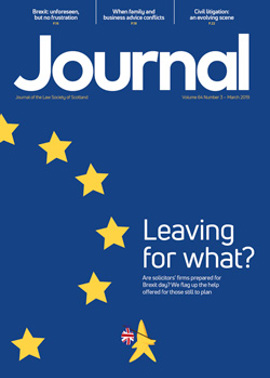Access right, right of access or right of way?

Over the past several months, I have been instructed in a number of cases which have, at their heart, a dispute about access. Some arise out of rights of access (and egress). Some concern access rights under the Land Reform (Scotland) Act 2003. A few involve alleged public rights of way. Those legal bases to establish a right to be on land may not be mutually exclusive, but they are separate and distinct. Each has its own available remedies.
However, I have recently identified a concerning trend of these distinct lines being blurred. Thus, I have seen an attempt by an individual (legally represented) to establish a public right of way due in part to a local authority bringing enforcement action under the 2003 Act. I have also seen a local authority serve an enforcement notice under the 2003 Act in respect of a gate which, it said, “obstructs a public right of way”.
The purpose of this note is to consider briefly the different reasons why individuals may be on land, and to consider what remedies may exist to enforce a right to “access”.
Right of access
Basis
The first reason why someone may be on land, and the one that is probably most often relied on, is that they have a real or personal right to be there. An individual may have been given permission by the owner to use a road or path for access. That right is personal, and will not transfer with title to the land.
Alternatively, a servitude right of access may have been created by express grant or by continuous possession for 20 years openly, peaceably and without judicial interruption (s 3, Prescription and Limitation (Scotland) Act 1973). In either case, the right is real, and will pass with title.
In either case, the right of access is limited by its grant, whether by deed or by order of court. The route to be used, the means by which it may be taken (e.g. pedestrian, vehicular, horseback), and the volume of traffic are all determined by reference to that grant. It follows that, in seeking to remedy interference with the right, careful consideration must be given to what the right entitles the holder to do.
Remedies
Prior to enforcement, the existence of the right may require to be set up. That is done by seeking a declaratory order from the court. The order sought must be carefully drafted to ensure that the full extent of the required access is granted by the court.
Once the right is established, the most common remedy to force compliance is interdict against a party from obstructing it. Again, the terms of the interdict must be framed in such a way as to ensure that the order will leave the party in no doubt as to what conduct is prohibited.
It may also be appropriate to obtain a positive order for the removal of an obstruction. That is becoming an increasingly popular option now that the power exists at sheriff court level to obtain such an order on an interim basis (s 88, Courts Reform (Scotland) Act 2014).
Access rights
Basis
In terms of s 1 of the 2003 Act, “(1) Everyone has the statutory rights established by this Part of this Act.
“(2) Those rights (in this Part of this Act called ‘access rights’) are (a) the right to be, for any of the purposes set out in subsection (3) below, on land; and (b) the right to cross land.”
By subs (3) access rights may be exercised for (i) recreational purposes, (ii) carrying on a relevant educational activity, or (iii) carrying on, commercially or for profit, an activity which the person exercising the right could carry on otherwise than commercially or for profit.
Access rights must be exercised responsibly (s 2). In assessing what amounts to responsible access taking, regard must be had to the Scottish Outdoor Access Code (s 10). Access rights apply to all land except that which is excluded under s 6 (e.g. to the extent that there is a place on the land affording a person privacy or shelter). Additionally, certain conduct (including, in particular, being on or crossing land in or with a motorised vehicle, or with a dog or other animal which is not under proper control) is excluded from access rights (s 9).
Remedies
It is the duty of local authorities to uphold access rights (s 13). Accordingly, in terms of s 14, local authorities, acting as access authorities, have the power to issue enforcement notices where it appears that the owner of land has done something, or failed to do something, for the purpose or main purpose of deterring the responsible exercise of access rights. The notice must set out the steps that the landowner requires to take and a timescale for compliance, under explanation that the local authority will take those steps if the landowner does not comply.
The proper exercise of s 14 was considered by the Inner House, First Division, last year in Renyana Stahl Anstalt v Loch Lomond and the Trossachs National Park Authority 2018 SC 406. First, it was clarified that s 14 can require a landowner to “take remedial steps to undo any action, including the locking of a gate, or to remove a sign or unlock a gate which he has ‘failed’ to remove or unlock as part of his duty of responsible management of his land, having regard to the right under s 1” (per Lord President at para 60).
Secondly, the purpose or main purpose of a landowner’s acts must be objectively assessed (per Lord President at para 64). Until this clarification, conventional wisdom was that the test was subjective, following the obiter dictum of the Inner House in Tuley v Highland Council 2009 SC 456.
However, enforcement action is not limited to local authorities. It is open to any person with an interest, by summary application in the sheriff court, to seek a declaratory order as to the existence and extent of access rights (s 28).
Separately, where a person entitled to exercise access rights is prevented from doing so, interdict may properly be sought against the landowner.
Right of way
Basis
The purpose of a public right of way is to allow an individual to get from A to B. It is a right to cross land, not to be on land. The components of a public right of way were set out in Rhins District Committee of Wigtownshire County Council v Cuninghame 1917 2 SLT 169, as being:
- public termini;
- use from end to end on a continuous journey;
- by a definite line; and
- (where established by prescription) continuous use for the prescriptive period of right.
What is meant by a public place for the purposes of identifying termini has been the subject of much judicial consideration. A non-exhaustive list of places which are potentially public is helpfully set out by Professors Cusine and Paisley in their text Servitudes and Rights of Way, at chapter 20. However, the key component is that the journey must be continuous. It would not be sufficient, for example, for an individual who resides somewhere along the route to make use of the route from his or her house to A and back on some occasions, and to B and back on others.
Remedies
Any member of the public may take action to enforce a public right of way. There are a number of established public rights of way, and a register of those is kept by Scotways. However, where there is a dispute as to the existence of a right of way, the appropriate step would be to seek a declaratory order that the right of way exists. Where the right of way is sought to be established by prescriptive possession under s 3 of the 1973 Act, declarator is required as a prerequisite of any further order. Much as with servitudes, care must be given to the framing of that order. A right of way only exists for the purpose that is expressed. Therefore, if it is for both pedestrian and vehicular use, it must say so.
Thereafter, interdict to prevent the obstruction of the right of way is the most likely remedy to be employed.
Conclusion
Clients who have issues with access will want to find the quickest way to re-establish a right that they believe they are entitled to use. When assisting them to assert their rights, I hope that this brief summary is a helpful signpost to help you show them the way to go.
In this issue
- How will Brexit affect my mother-in-law?
- Settling the debate on sequestration
- Taking wellbeing seriously
- How will personal data continue to flow after Brexit?
- Buildmark, and a little extra help for NHBC
- Reading for pleasure
- Opinion: Laurie Anderson
- Book reviews
- Profile: Lord Mackay of Clashfern
- President's column
- People on the move
- Is your legal software ready to remain compliant in 2019?
- What's the deal?
- Ready to leave?
- A tapering opportunity
- Brexit: no dealbreaker either
- The business of divorce
- Trailblazing 12
- Cohabitants: rebalancing the law
- Litigation: an evolving scene
- Chain transactions
- When delay is not fatal
- Data protection – deal or no-deal?
- Two cases and an order
- Reshaping trade mark law
- When the wheels come off
- Parentage or privacy?
- Access right, right of access or right of way?
- Team of one
- Public policy highlights
- OPG update
- Housing specialism added to accreditation list
- At the boundary's edge
- Keep the dual role
- Executry and trust accounting: new guidance
- Moving nightmares
- Accredited paralegal update
- Sign up for conference
- Accredited Paralegal Committee profile
- Ask Ash






